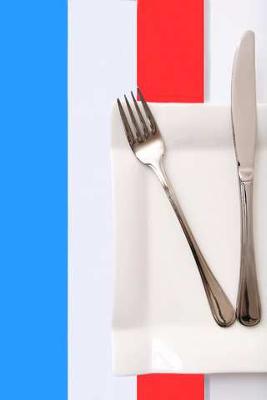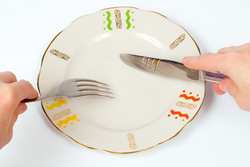French Table Manners
by Richard Bash
(Pendleton, Indiana)

Learn the basics of French table manners with these few rules. Nothing too complicated - it is a lot about respect, a little about looking good, and all about enjoyment.
Question: Kim, explain how the place setting is arranged. Do the forks of various sizes go on the left, like America, or some other way? Assume at least a 4-course meal, requiring a salad fork, a dinner fork, a knife, spoon and dessert spoon.
Thanks.
Answer: Hi Richard,
Thanks for writing to me with your question. Because I have already covered your question on another page (see French Table Settings), I thought I would tackle French table manners here. The two subjects go hand in hand and of course complement one another.
Most French table manners are probably similar to ones you grew up with. Things like do not open your mouth when you are eating and sit up straight. But there are some rules that are perhaps quite particular to French society and are good to know about if you are planning a trip to France. Of course, it can be fun learning about the etiquette of another country, even if you are not planning a trip!
French Table Manners in General . . .
It is all about respect.
The most important rule of any etiquette system is to always treat others with respect. Thoughtfulness towards your fellow diners should be your guiding light for any dining experience.And looking good.
After that, in France there is considerable attention given to keeping the table looking orderly and clean. Make an effort not to get crumbs on the table cloth, discretely wipe your mouth before taking a sip of water or wine, do not crumple up your napkin, and in general pay attention to what you are doing. Your goal is to leave the table looking as good as when you arrived.And enjoyment.
A big difference between the French dining experience and what you may be used to is that a meal is meant to be lingered over. The food is almost always served in courses and even weeknight meals in a family setting may take over an hour. This is your time to enjoy life - your food, your family, your community.French Table Manners in Particular . . .
- Gifts for the host. Wine and food gifts should only be offered to close friends and family. For more formal occasions, send flowers before or after the event. Bringing flowers is a big no-no because then the host may feel bothered by having to arrange them.
- Bon appétit. Despite its widespread, saying this right before dining is actually considered rude because it makes reference to digestion, not a polite topic of conversation. I say follow the crowd on this. If someone else says it, you can say it back or just say "merci".
- Position your hands. No elbows on the table Mabel. But no hands in the lap either. Your hands should lay quietly on the table when they have no other occupation.
- Posture. Sitting up straight is absolutely essential. Your feet should rest on the floor and you should not cross your legs.
- Conversation topics. In conversation, avoid the three deadly topics: religion, politics, and money. Just don't go there.
- Listening. Do not cut off anyone in conversation, even your spouse. Yeah, sure, everyone knows this, but how many of us truly respect what other people have to say?
- Knife and fork. According to French table manners, the knife stays in the right hand and fork in the left at all times. None of this funny hand switching that goes on in other countries. This is one eating custom you may take quite a fancy to as it does truly simplify the task.

As For Food . . .
- Bread. Break off a piece of bread to eat it. Do not use your knife to cut it and never take a bite directly out of the bread. If there is no special plate for it, the bread just goes on the tablecloth next to your plate.
- Fruit. Ok, seriously, good luck with this one. You are supposed to peel the fruit - be it a banana, a pear, or something else - with your knife and fork. You then slice it with the same tools. Cherries are a bit easier. You can eat them with your hands and discretely dispose of the pits in your closed fist before placing them on your plate.
- French fries and pizza. Keep that knife and fork firmly in your hands. There are very few foods that a French person will eat with their hands.
- Salad. This is a truly arcane bit of French table manners, but nonetheless it is respected: you must not cut your lettuce. Salad is eaten by folding the lettuce leaves into neat little packets on the tines of your fork. The reason popularly given for this is that once upon a time, the vinegar in the salad dressing could oxidize the metal knife and stain it. Why they were not concerned about the poor fork, I can not say!
How about it? Does anyone know some important French table manners that I am missing from this short list? As always, I would love to hear from you!
Comments for
|
||
|
||
|
||
|
||
|
||
|
||
|
||
|
||
|
||
|
||
|
||